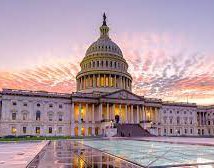Two significant climate bills were proposed in the US midterm elections, though only one passed. Experts are looking for more policy action that specifically addresses fashion. [Climate wins at US midterms fail to address fashion's impact - voguebusiness.com]
Sustainability was on the ballot in two elections in the US midterms. Yet, despite some wins that may have implications for textile producers, fashion’s impact was not a focus for policymakers. Experts say it was a missed opportunity.
New York delivered a big win for the climate with the passage of the Clean Water, Clean Air, Green Jobs Environmental Bond Act, a $4.2 billion bill that will enable the state to invest in efforts to both slow climate change, and help local communities adapt to it by flood-proofing neighbourhoods and improving public health, among other efforts.
The bill could be relevant for local textile production if funding goes to improving agriculture, says Rachel Kibbe, CEO of consultancy Circular Services Group and co-host of the podcast Hot Buttons. However, the industry should have been given more direct consideration, she argues. “Textiles aren’t contemplated in a lot of this stuff. That’s part of the educational challenge we have [with policymakers] — we’re still at the very beginning,” says Kibbe. “Some of these issues, fashion can easily apply to, but they haven't been included.”
The other significant climate bill, Prop 30 in California, which would have raised taxes on the wealthiest residents to help speed the transition to electric vehicles, did not pass. Observers attribute that to lobbying by business interests. “The outcome of Prop 30 is unfortunate, but there were so many factors specific to that campaign that I think it's unwise to extrapolate too much,” says Maxine Bédat, director of non-profit New Standard Institute and author of Unraveled: The Life and Death of a Garment.
Elsewhere, smaller environmental initiatives — climate funding and recycling expansion in Colorado; and a $50 million green bond in Rhode Island, for instance — passed with resounding margins, though control of Congress is unknown at the time of writing, as some key races have not been called.
The lack of specific fashion policy on any ballot is symptomatic of how widely, and for how long, the industry has escaped the attention of policymakers, experts say. To tackle the industry’s impact properly will require more robust efforts — with global reach — than any that were up for a vote this election. “Most of [fashion’s] impact is unregulated because it's offshore,” says Kibbe.
Elizabeth Cline, advocacy and policy director at the non-profit Remake, agrees. She supported the New York bill, but says the stakes for fashion lie elsewhere. “Climate resilience is so important, but politicians are ignoring where emissions are set to climb and where communities are already being impacted by climate change,” she says. “We also want to see climate policies that help garment-producing countries in the Global South to decarbonise and weather climate change, as that’s where emissions are set to climb and where climate change is already ravaging local communities.”
While it may have been largely absent from the midterms, US policymakers have started to turn their attention to fashion. Advocates are closely following two bills that were introduced this year.
The Fashion Sustainability and Social Accountability (Fashion) Act, sponsored in the New York legislature by state senator Alessandra Biaggi and assembly member Anna R Kelles, would require all fashion companies that do business — sell products — in New York and generate more than $100 million in revenues to map at least 50 per cent of their supply chains and disclose their environmental impacts. The Fashioning Accountability and Building Real Institutional Change (Fabric) Act, introduced to the US Senate in May by senator Kirsten Gillibrand, would extend the anti-wage theft principles of California’s SB62, considered to be groundbreaking when it passed last year, nationwide; it also includes financial incentives to encourage brands to manufacture in the US.
The fate of the Fabric Act depends on Congress (the Fashion Act, a state-level proposal, does not), but experts are optimistic about its future regardless of who ends up in control of the federal legislature because of its simultaneous focus on sustainability and the economy. It “has clear bipartisan appeal, and we see some potential new allies coming into the Senate, which is exciting,” says Cline. “More importantly, with the election out of the way, everyone can get back to work pushing this bill. We continue to hear from members of Congress that fashion policy is moving up the agenda in Washington. We really expect the momentum to pick up behind the Fabric Act and bills like it.”
The American Circular Textiles Group, which formed in June and expects to publish a policy white paper in early 2023, says its priorities — green job creation, domestic supply chains and expanding circular business models such as resale and repair — also have strong bipartisan support.
“Supply chains, jobs, the environment are issues that stand across party lines,” says Kibbe, who was recently appointed the group’s executive director. “I don’t foresee our strategy to be any different [under a new Congress], because this really is about domestic security, in a lot of ways. Providing jobs — green jobs — protecting our supply chains, bolstering the economy; I think those are all bipartisan issues.”



